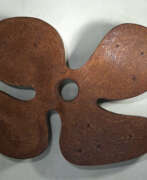Patination

Patination
Patination is a technique used to create a colored or textured finish on the surface of metals like bronze, copper, and iron. It involves applying chemical treatments or other methods to produce a desired effect. This process can be natural, occurring over time as metals react with their environment, or it can be artificially induced by artisans to achieve specific artistic goals.
The process of patination is particularly significant in art conservation, as it helps to recreate the natural aging of metals, preserving their historical integrity while enhancing their aesthetic appeal. For example, the Statue of Liberty's iconic green color is a result of natural patination of its copper surface.
Various techniques are employed in patination, including chemical baths, heat applications, and mechanical methods. Artists and conservators use these techniques to achieve a wide range of colors and textures. The use of specific solutions, like copper sulfate and ammonium chloride, allows for controlled color variations, as seen in the detailed work by Tiffany & Co. on copper objects.
For more insights into patination and updates on new artworks and auction events, sign up for our newsletter. You'll receive exclusive alerts about new product sales and auction opportunities related to patinated artworks.
| Country: | Asia, Europe |
|---|---|
| Start of the period: | XIV century |





